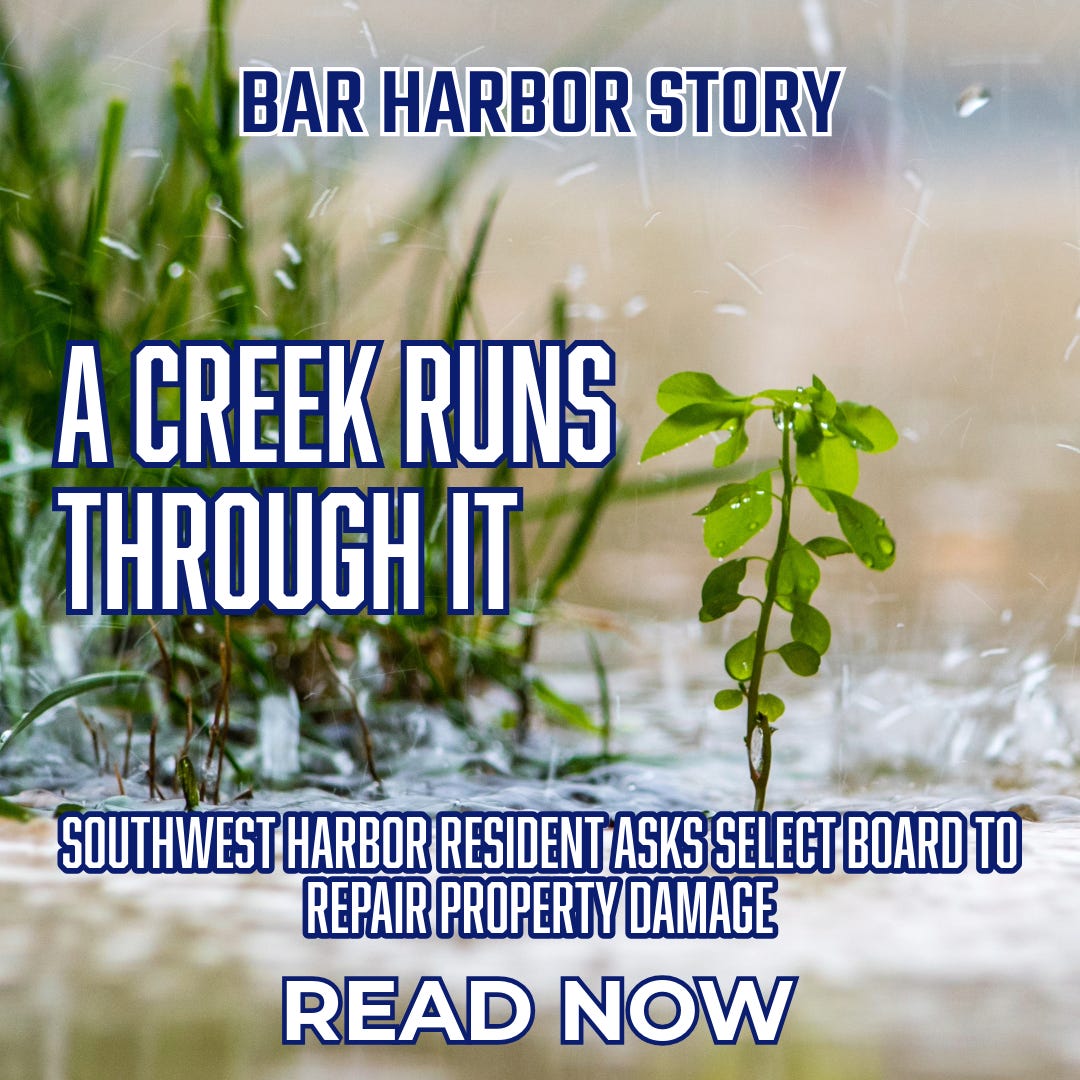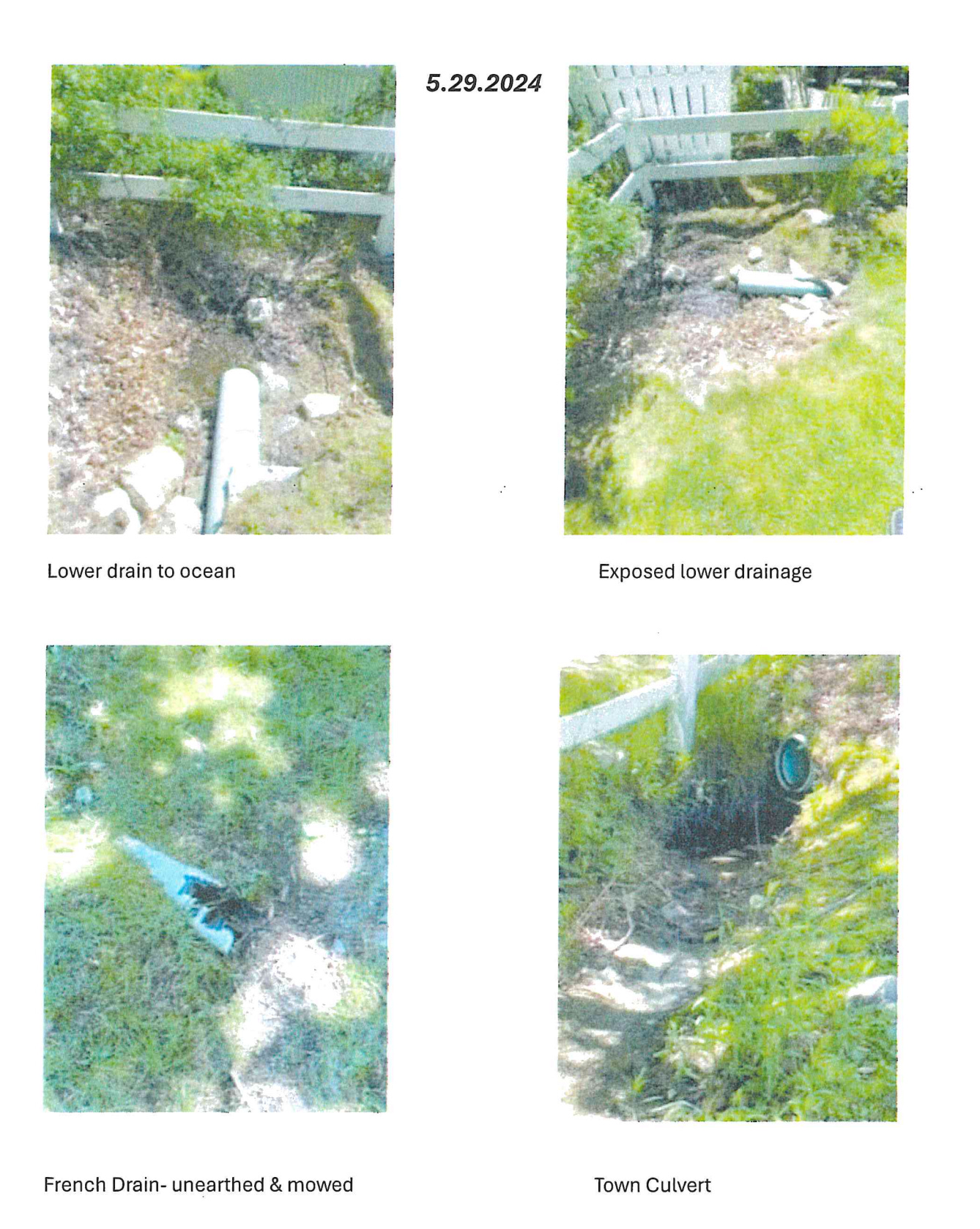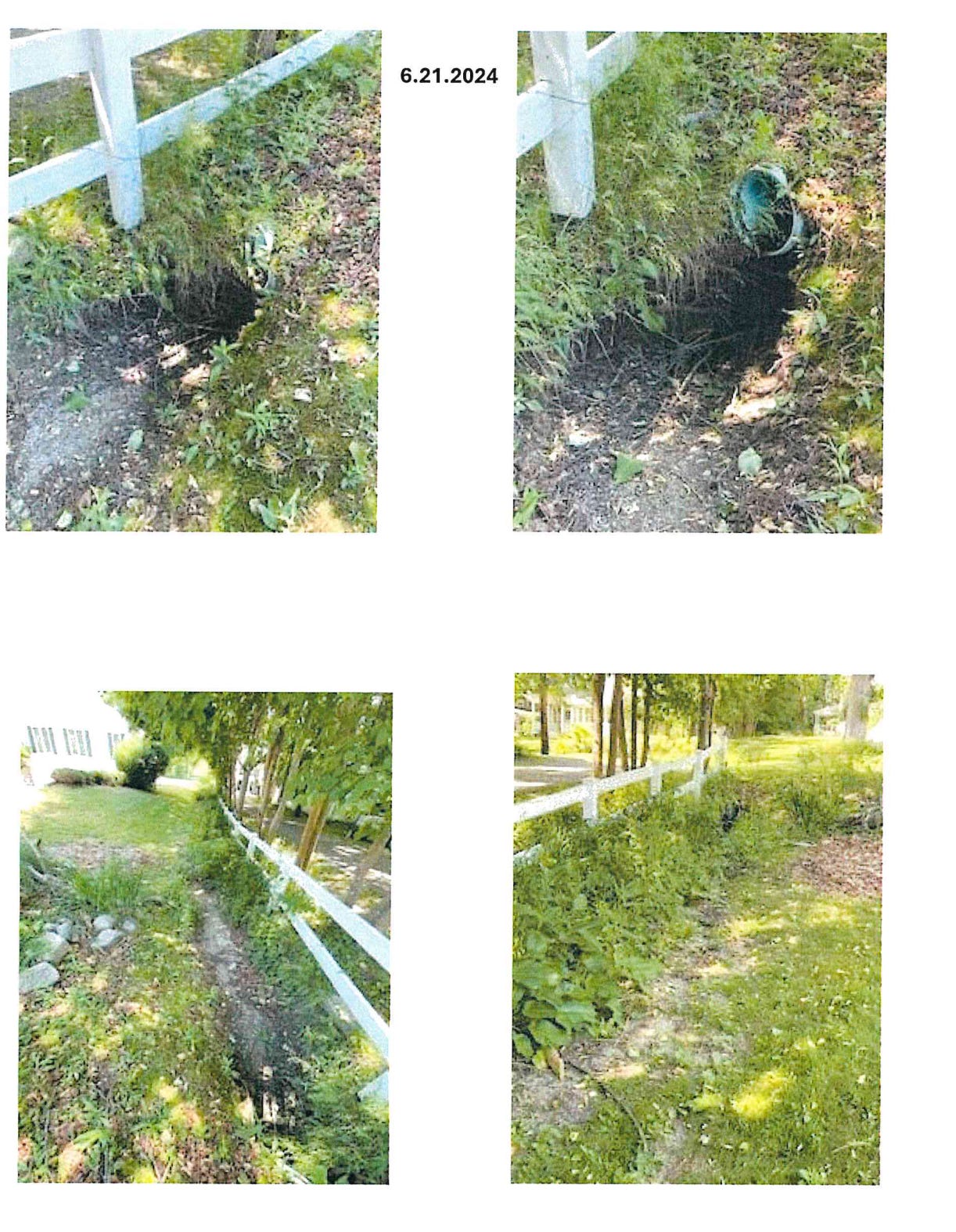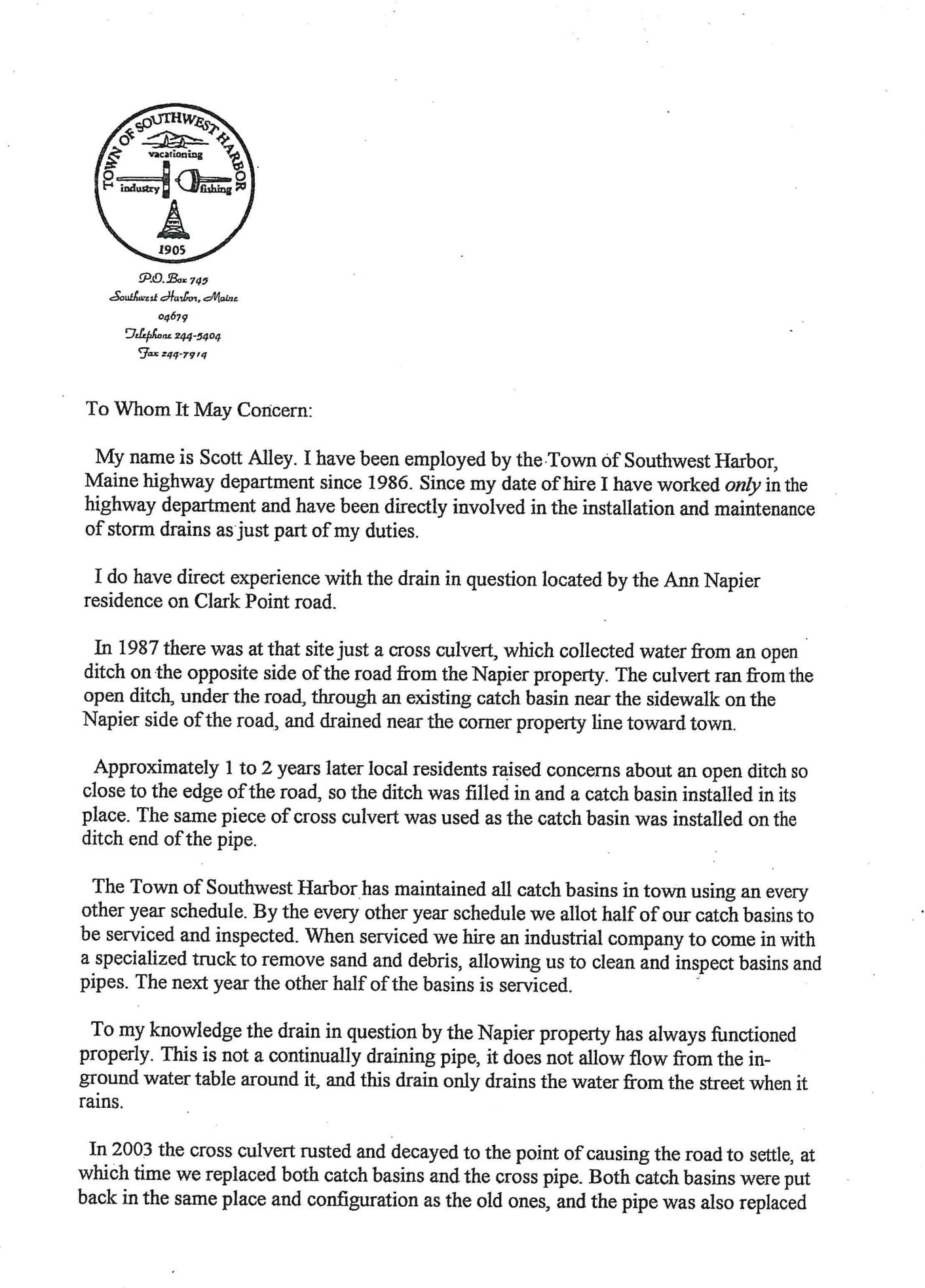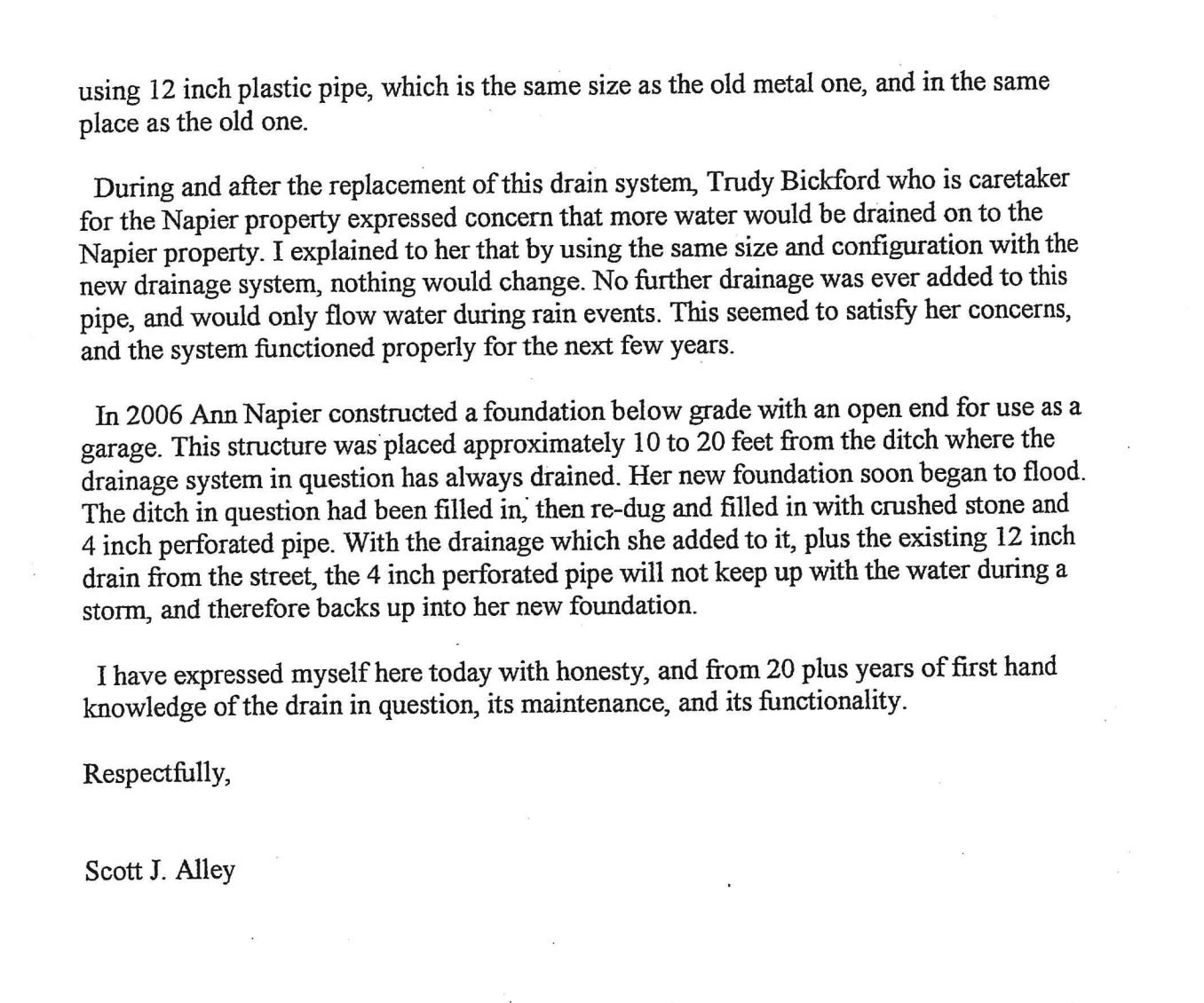SOUTHWEST HARBOR— When Anne Napier went before the Southwest Harbor Select Board last month, she requested help from the town with the drainage issues on her property that she says stem from the town’s pipe, which she believes has no right to be there.
“I am asking the town to pay for repairs to address current damage to my property and for the town to take further action to permanently prevent future damage,” she wrote in an April 21 letter to Town Manager Marilyn Lowell.
“It’s a mess,” she told board members on Tuesday night.
According to Napier, the town has no right-of-way across her property and that she could remove the pipe if she chose to do so.
“It doesn’t matter what time of year, I have a creek running through my property,” she said.
After consulting Acadia Stone and Garden, she believes that the best option would be to extend the existing 12-inch pipe and drain outlet and bury it, and also replace the soil so that all the now exposed pipes are covered. That would cost approximately $1,200 for labor and materials.
On Tuesday, Lowell offered a different suggestion after she went to the site, spoke to Maine Municipal Association’s legal team, and discussed the drainage issue with Road Foreman Scott Alley.
Lowell suggested putting an elbow on the culvert to divert water from the fence, filling in the hole with crushed stone, filling in around the fence post, and doing other fixes to help with erosion at the site.
“Scott (Alley) thinks the materials would be about $500-$600. The labor portion was going to be done by Acadia Stone, so we are not sure if the $1,200 price will change with the change in materials,” Lowell wrote in the packet to the board.
She also explained potential repairs verbally.
“The pictures were extremely helpful as were the narrative that you wrote, Scott, which was great,” said Vice Chair Natasha Johnson, referencing a letter from Alley included in the packet. She thought that the solution was a good compromise to help mitigate the situation.
Napier disagreed.
“I have tried that,” she said and added, “I don’t see the idea of spending the town’s money to do another Band-Aid,” for two to three years as a good idea.
Her property, she reiterated, has no easement with the town for drainage. She said she was a master gardener who understood gardening and drainage.
Johnson said her concern is that in the proposal the pipe ends at the next property’s land. There is a swale on the next property, Napier said. And the drainage already goes through her property onto the next property owner’s.
Select Board members asked if the owner of the neighboring property would be okay with her plan of extending the pipe to his property. She said that she believed he would be fine with it because of his own current remediation for the drainage that already occurs. The board decided to check with him before moving forward in any direction.
Napier said she has also consulted an attorney about the issue.
“If the issue persists, less revisit it,” James Vallette suggested.
“It damages my garden and consistently damages the memorial garden that I set up for my daughter who died a few years ago,” Napier said, and she added that the town’s compromise plan doesn’t address water flowing above the land.
Vallette asked if there was any problem trying the solution now and coming back if it doesn’t work. Napier repeated that she was not interested in coming back again and again.
She said she’d have them cap the pipe and remove it if she can’t find a solution with the town.
In that April 21 letter to Lowell, Napier expressed her concern that the town’s storm water drainage “is causing extensive and on-going damage to my property at 138 Clark Point Road.”
She purchased the property in 1979 and it’s her primary residence.
“At the time of purchase, there was a town storm sewer drain, which was not functioning, located across from my property on the edge of what is now Harbour Cottage Inn property,” she wrote. “So my property was getting a lot of storm water run-off from Clark Point Road and Dirigo Road.”
The sewer pipes and the water pipes were repaired on lower Clark Point Road, and she told the town about the issues, asking them to install parallel storm water piping to handle the runoff.
They did not do so, she said.
She built a second residence on her property in 2006 and 2007. She installed three courses of French drains to mitigate her property’s run-off. She also added a driveway drain. She also tried to create a lip between her driveway and the street to prevent runoff.
“All of these drainage systems worked well to handle my own storm water runoff,” she wrote, “but without the town fully addressing its own storm water responsibilities, it was and still is insufficient to handle the town’s storm water.”
Fast forward a few years, she said, and “public works employees showed up and began excavating under the sidewalk and into my yard to install a new 12” storm sewer drain, which would drain across my property onto neighboring property and then to (the) harbor.”
She wrote that she’d done everything to mitigate damage from the town’s run-off.
She said she’s lost three feet of depth to the yard in one corner, the driveway drains are now exposed and open to damage, and her gardens are damaged each year. Because of the volumes of water, the lawn has eroded underneath the pipe’s outlet creating a 12-inch depression and the sewage pipe outflow has eroded the soil from the bank where the fence post footings are.
CONSERVATION COMMISSION APPOINTMENT AND VULNERABILITY ASSESSMENTS
Kathryn Strand, who is the development director at the Land and Garden Preserve was unanimously appointed to the Conservation Commission as an associate member.
“I have just fallen in love with this town and I wanted to do something civic to help the town out,” Strand said. “I’m really impressed by the work that they do and how devoted they are and how much they get done.”
The town also talked about undergoing a climate vulnerability assessment, similar to one that Mount Desert is undertaking.
“We are one of the top fishing communities in the state,” Vallette said and the working waterfront is getting “decimated” by storms. That was one of the things he’d like to focus on.
The Select Board also approved the salt bid price of $75.60 per ton for the fiscal year 2024-2025 season. She also gave an update about the EV charging station.
Lowell has attended two meetings with consultants from Titan Energy about the stations. The current one is out of date and can’t be updated to take credit cards. The town’s bathroom electric bill goes as high as $650 each summer because of the station. She proposed new chargers that would charge within four hours rather than all night, which is the current practice for many, she said. Software and hardware costs could be between $7,500 and $12,000. Installation would cost approximately $15,000. There would be a network charge that would be between $15 and $30 each month.
There was one person attending in person, two people, not including journalists, online.
LINKS TO LEARN MORE
If you’d like to donate to help support us, you can, but no pressure! Just click here.





